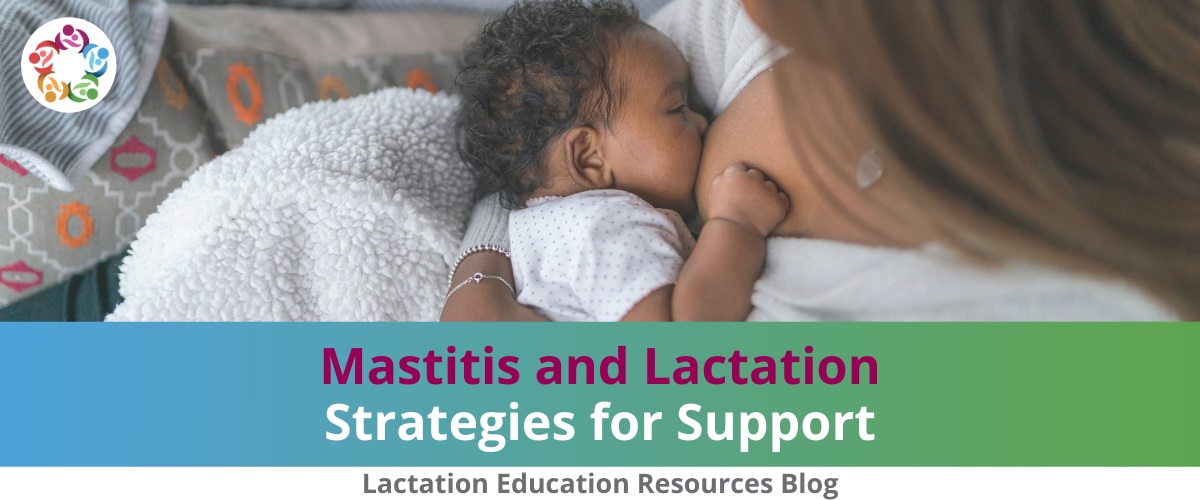
You answer the phone and find a distressed client on the line. They’re experiencing pain in their breast, along with redness, heat, and swelling. The pain is getting worse, and they need your help.
What questions will you ask to start to evaluate the problem? What differential diagnoses will you consider?
Swollen breasts, pain, warmth, lumps, and other symptoms can indicate several different problems. Your client could be experiencing engorgement, mastitis, a plugged duct, or a breast abscess. How can you distinguish so that you can offer the best advice?
In her LER course “Engorgement and Mastitis,” Nekisha Killings, MPH, CLC, IBCLC, RLC covers these common—yet potentially serious—breastfeeding issues. In a previous blog post we shared the ins and out of engorgement.
Now let’s tackle mastitis.
Clinical Features
Mastitis is inflammation of the breast, with or without infection. Only one breast is typically affected. Most cases occur within the first 12 weeks, and symptoms are most common in the upper, outer quadrant of the breast. Fair skinned parents may notice redness or streaking, while more deeply pigmented parents may notice slight color changes in the affected area. Heat in the breast, and hardness or lumps accompanied by chills, fever, and flu-like symptoms are all commonly reported.
Causes
Failure to regularly and effectively drain the breast is the primary cause of mastitis. When too much milk builds up, it’s forced out of the alveoli into the surrounding tissue, causing localized inflammation. A bacterial infection can also be present, but according to Killings, it can be difficult to determine whether this is the case. Culturing is not very useful, because many healthy breastfeeding parents have pathogenic bacteria in their milk, and the presence doesn’t predict symptoms.
Risk Factors
Parents who have had nipple damage are at increased risk, since this provides a doorway for bacteria. Other risk factors are illness of parent or baby, working without adequate pumping breaks, parental stress or fatigue, anemia, malnutrition, and Type 2 Diabetes. Skipping or delaying feeds and feeding on a schedule also increase risk, as do oversupply and rapid weaning. A parent with a nipple piercing can be at higher risk of infectious mastitis.
Treatment
Killings offers an easily-remembered phrase for the essentials of mastitis treatment: “Heat, rest, and empty the breast.”
Apply warm, moist heat before feeds, and suggest beginning on the affected side, since baby’s suck will be stronger and remove more milk. If baby isn’t completely emptying the breast, pump to ensure full drainage. A parent with mastitis also needs a lot of rest—ideally, bed rest— and increased fluids. Above all, make sure nursing continues. “Stopping will make mastitis worse,” Killings says.
What about antibiotics? A prescription most likely is not needed if symptoms are mild and have lasted less than 24 hours and the client is not acutely ill. Cases lasting longer and with more severe symptoms may need antibiotic treatment. And mastitis that is not improving should be carefully assessed to rule out inflammatory breast cancer.
To sharpen your skills in evaluating engorgement, mastitis, plugged ducts, breast abscess, and more, enroll in LER’s course Engorgement and Mastitis, taught by Nekisha Killings, MPH, CLC, IBCLC, RLC.

You answer the phone and find a distressed client on the line. They’re experiencing pain in their breast, along with redness, heat, and swelling. The pain is getting worse, and they need your help.
What questions will you ask to start to evaluate the problem? What differential diagnoses will you consider?
Swollen breasts, pain, warmth, lumps, and other symptoms can indicate several different problems. Your client could be experiencing engorgement, mastitis, a plugged duct, or a breast abscess. How can you distinguish so that you can offer the best advice?
In her LER course “Engorgement and Mastitis,” Nekisha Killings, MPH, CLC, IBCLC, RLC covers these common—yet potentially serious—breastfeeding issues. In a previous blog post we shared the ins and out of engorgement.
Now let’s tackle mastitis.
Clinical Features
Mastitis is inflammation of the breast, with or without infection. Only one breast is typically affected. Most cases occur within the first 12 weeks, and symptoms are most common in the upper, outer quadrant of the breast. Fair skinned parents may notice redness or streaking, while more deeply pigmented parents may notice slight color changes in the affected area. Heat in the breast, and hardness or lumps accompanied by chills, fever, and flu-like symptoms are all commonly reported.
Causes
Failure to regularly and effectively drain the breast is the primary cause of mastitis. When too much milk builds up, it’s forced out of the alveoli into the surrounding tissue, causing localized inflammation. A bacterial infection can also be present, but according to Killings, it can be difficult to determine whether this is the case. Culturing is not very useful, because many healthy breastfeeding parents have pathogenic bacteria in their milk, and the presence doesn’t predict symptoms.
Risk Factors
Parents who have had nipple damage are at increased risk, since this provides a doorway for bacteria. Other risk factors are illness of parent or baby, working without adequate pumping breaks, parental stress or fatigue, anemia, malnutrition, and Type 2 Diabetes. Skipping or delaying feeds and feeding on a schedule also increase risk, as do oversupply and rapid weaning. A parent with a nipple piercing can be at higher risk of infectious mastitis.
Treatment
Killings offers an easily-remembered phrase for the essentials of mastitis treatment: “Heat, rest, and empty the breast.”
Apply warm, moist heat before feeds, and suggest beginning on the affected side, since baby’s suck will be stronger and remove more milk. If baby isn’t completely emptying the breast, pump to ensure full drainage. A parent with mastitis also needs a lot of rest—ideally, bed rest— and increased fluids. Above all, make sure nursing continues. “Stopping will make mastitis worse,” Killings says.
What about antibiotics? A prescription most likely is not needed if symptoms are mild and have lasted less than 24 hours and the client is not acutely ill. Cases lasting longer and with more severe symptoms may need antibiotic treatment. And mastitis that is not improving should be carefully assessed to rule out inflammatory breast cancer.
To sharpen your skills in evaluating engorgement, mastitis, plugged ducts, breast abscess, and more, enroll in LER’s course Engorgement and Mastitis, taught by Nekisha Killings, MPH, CLC, IBCLC, RLC.